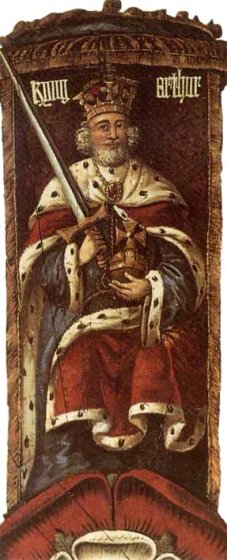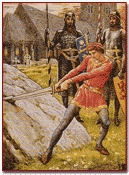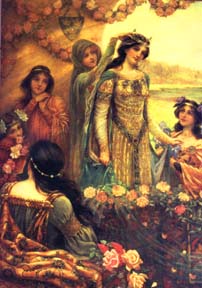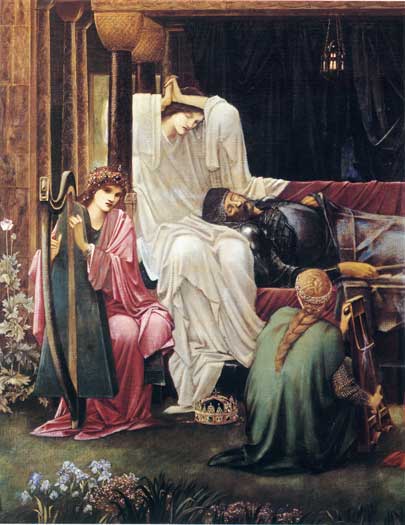King Arthur
Welcome to the place where you will find all the information you could possibly want on the chief of them all, King Arthur himself. Below you will see links leading to various aspects of the King's life. Click to find out about his knights or his relatives.
Arthur's Birth and Early Years
The Breton King
Riothamus the King
The Dumnonian King
The Cumbrian King
The Pennine King
The Elmet King
The Scottish King
King Arthur was born of Uther and his wife, Igraine of Lionesse. He was born at Tintagel, but was taken to London by Merlin to be brought up by Sir Hector de Mowen.
The Powysian King
The Rhos King
The Dyfed King
The Glamorgan King
St. Arthmael the King
The Roman King
Arthur's Birth and Early Years
After his death, Ambrosius was succeeded by his brother, Uther, who, during his pursuit of Gorlois and his irresistable wife, Igraine (Ygerna or Eigr in some texts), back to their lands in Cornwall, was aided by Merlin. As a result of a deception made possible by Merlin's powers, Uther was transformed into the image of Gorlois. He entered their castle, managed to fool Ygraine into thinking he was her husband, had his way with her and in the course of things, conceived a child, Arthur. Poor Gorlois, not knowing what was going on, went out to meet Uther in combat, but instead, was slain by Uther's troops. (See Igraine and Gorlois) Later legends say that Arthur had three half-sisters: Morgawse, Elaine (Blasine) and Morgan le Fay. Morgawse had married King Lot of Orkney, Elaine (Blasine) was married to King Nentres of Garlot, while Morgan was wife of King Urien of Gorre, brother of Lot.
Tradition has it that after King Uther's death there was no king ruling all of England. Merlin had placed a sword in a stone, saying that whoever drew it out would be king. Arthur did not know his true status but had grown up living with Sir Ector and Sir Kay, his son. The young Arthur pulled the sword from the stone and Merlin had him crowned the King of Britain. This led to a rebellion by eleven rulers which Arthur put down.
Normally, Arthur's symbol is that of the Red Dragon, like that of his father Uther, who had a nickname Pendragon attached to his name. However, Arthur's symbol was also that of Boar of Cornwall, mainly because Cornwall, particularly the castle Tintagel, was his birth place. The warcry of Arthur and the Round Table was "Clarence!".
Guinevere and Arthur's Adventures
Arthur married Guinevere after falling deeply in love with her, despite Merlin's warnings. Guinevere's father gave Arthur the round table as a dowry. Arthur said to have no children from his wife Guinevere, except for in the text Perlesvaus, where Lohot was their son of Arthur and Guinevere. However, Lohot (or Loholt) was said to be Arthur's son, not by his wife Guinevere, but more frequently by a woman named Lisanor. Lohot was one of the Round Table knights. Lohot was also one of the knights captured by the lord of Dolorous Guard, where he fell ill during the imprisonment. According to Malory, the son was named Borre and the mother was named Lionors. The similarity between the two women's names - Lisanor and Lionor, suggested that Lohot and Borre is one and the same person. According to the ninth century historian, Nennius, Arthur had a son named Amr, as well as a dog, called Cabal. Nennius say that Arthur had killed his own son, but doesn't state why he had done so. Arthur had set up tomb near the spring called Licat Amr, in the region of Ercing. What was marvelous about this tomb is that it change in length in various days. Amr could be the prototype to Mordred. As for his dog, the mound was called Carn Cabal, located in Buelt. Cabal was killed when they went hunting against the wild boar Troynt (possibly Twrach Trwyth).
However, his most famous son was Mordred. Normally, in the early tradition, Mordred was Arthur's nephew, because Mordred was the son of King Lot and Anna or Morgawse, the sister of Arthur. But some texts implied that Mordred was his son by Arthur's half-sister, Morgawse. In the Suite du Merlin, Arthur had unwittingly slept with Morgawse, because he did not know that she was his half-sister. Some even say that Morgan le Fay was Mordred's mother. In the Mort Artu, Gawain did not know that Mordred was only his half brother until Mordred had seized power during their absence in the wars against Lancelot and the Romans. The only person who knew of Arthur relationship with Mordred was Morgawse and Merlin.
The Welsh Triad listed Arthur of having three mistresses - Indeg daughter of Garwy the Tall, and Garwen ("Fair Leg") daughter of Henin the Old, and Gwyl ("Modest") daughter of Gendawd ("Big Chin").
According to Geoffrey of Monmouth, Arthur was a great warrior king, unsurpassed in prowess and diplomacy. Arthur was seen as a world conqueror, whose empire comprised of Wales, Scotland, Ireland, Norway, Denmark, Germany, Brittany, Normandy and Gaul. His reign only ended when his nephew Mordred tried to deposed him as king of Britain and forced his wife Guinevere to marry him.
By the time of the 13th century, Arthur became more like a typical king and less of a hero. Medieval romances was about the actions of the hero in the story (a knight in this case). To the writers of that time, a king can't just leave his court to seek out adventure. A king had duties that tied him to the throne and to his kingly duties.
The legend of Kind Arthur and the Knights of the Round Table began to focus away from the king himself and more on the knights. These heroes became the central characters of various tales, while Arthur began to take a less active role in the tales. His character became more weak and ignoble, rather than the great warrior king of the early tradition.
The last battle of Arthur took place between He and the forces of his evil nephew, Mordred. Arthur delivered the fatal blow to Mordred in the battle, but in the process Arthur was struck a mortal blow himself. It was then that he commanded Sir Bedivere to throw Excalibur back into the Lake. After a few mishaps, the sword was thrown into the lake where a hand reached out of the water and caught it by the hilt. The legend then claims that a boat arrived with three or four queens in it to take Arthur to Avalon where he could be healed and live in peace. Another version of this tale says Arthur died there, by the lake, from the blow that Mordred had struck.
The Vulgate Cycle introduced a different ending for Arthur and his kingdom. The cause of the death of Arthur, was the adultery of Lancelot and Guinevere, the disappearance of the Grail from Britain and the betrayal and treason of Mordred, his son by his half-sister Morgawse.
For a more comprehensive look at who Arthur really was, visit my Truth and Legend Page.
Copyright � The Arthurian Kingdom

The Breton King
Riothamus the King
The Dumnonian King
The Cumbrian King
The Pennine King
The Elmet King
The Scottish King
The Powysian King
The Rhos King
The Dyfed King
The Glamorgan King
St. Arthmael the King
The Roman King

Geoffrey of Monmouth claims Arthur was High-King of Britain. He was son of King Uther Pendragon and nephew King Ambrosius Aurelianus.
Geoffrey Ashe argues that King Arthur was a historical King in Brittany known to history as Riothamus, a title meaning "Greatest-King". His army is recorded as having crossed the channel to  fight the Visigoths in the Loire Valley in 468. Betrayed by the Prefect of Gaul, he later disappeared from history. Ashe does not discuss Riothamus' ancestry. Riothamus was probably exiled to Britain during one of the many civil wars that plagued Brittany. He later returned in triumph to reclaim his inheritance, but was then killed in an attempt to expel Germanic invaders. The main trouble with this Arthurian identification is that it pushes King Arthur back fifty years from his traditional period at the beginning of the sixth century.
fight the Visigoths in the Loire Valley in 468. Betrayed by the Prefect of Gaul, he later disappeared from history. Ashe does not discuss Riothamus' ancestry. Riothamus was probably exiled to Britain during one of the many civil wars that plagued Brittany. He later returned in triumph to reclaim his inheritance, but was then killed in an attempt to expel Germanic invaders. The main trouble with this Arthurian identification is that it pushes King Arthur back fifty years from his traditional period at the beginning of the sixth century.
Welsh tradition also sees Arthur as High-King of Britain but tends to follow different genealogies. These show Arthur as grandson of Constantine but, this time, he is Constantine Corneu, the King of Dumnonia. Traditional Arthurian legend records three Kings of Dumnonia during Arthur's reign: Constantine's son, Erbin; grandson, Gereint and great grandson, Cado. Nowhere is there any indication that these three were closely related to Arthur, nor that he had any claim on the Dumnonian Kingdom. Nor is their any explanation as to why a Dumnonian prince would have been raised to the High-Kingship of Britain. Arthur's connection with this area of Britain is purely due to his supposedly being conceived at Tintagel, the residence of his mother's first husband, and buried at Glastonbury, the most ancient Christian site in the country.
The Clan Campbell trace their tribal pedigree back to one Arthur ic Uibar: the Arthur, son of Uther of tradition. Norma Lorre Goodrich uses this fact to argue that Arthur was a "Man of the North". Goodrich places Arthur's Court at Carlisle. As the capital of the Northern British Kingdom of Rheged, this seems an unlikely home for Arthur, who was not of this dynasty. Prof. Goodrich relies heavily on late medieval literary sources and draws imaginative conclusions.
There was a Northern British King named Arthwys who lived in the previous generation to the traditional Arthur. He was of the line of Coel Hen (the Old) and probably ruled over a large Kingdom in the Pennines.
Another Northern British Arthwys was the son of Masgwid Gloff, probably a King of the Elmet region of modern West Yorkshire. Nothing is known of this Prince who was exactly contemporary with the real King's traditional period. Though it is unlikely that he held his own kingdom, his exploits may have contributed to King Arthur's story.
The Scots, though fresh from Ireland, also used the name Arthur for a Royal Prince. Arthur, the son of King Aidan of Dalriada, was probably born in the 550s. David F. Carroll has recently argued that this man was the real Arthur, ruling Manau Gododdin from Camelon (alias Camelot) in Stirlingshire.
Graham Phillips and Martin Keatman identify Arthur as Owain Ddantwyn (White-Tooth), a late 5th century Prince of the House of Cunedda (more specifically of Gwynedd). Their arguments, however, are wholly unconvincing, and contain many unresolved discrepancies. Owain's son, Cuneglasus (known from Welsh pedigrees as Cynlas) was among the five Celtic Kings condemned in the writings of Gildas. Through a misinterpretation of this account, Keatman & Phillips imply that Cuneglasus was the son of one Arth, ie. Arthur. They further claim that he, and therefore his father, Owain, before him, must have ruled Powys, as this is the only Kingdom un-reconciled with Gildas' Kings. However, Cynlas lived at Din Arth in Rhos. He was not the son of Arth. In traditional Welsh manner the Kingdom of Gwynedd had been divided between his father, Owain, who received Eastern Gwynedd (ie. Rhos) and his uncle, Cadwallon Lawhir (Long-Hand) who took the major Western portion. During this period, Cyngen Glodrydd (the Renowned) was ruling Powys.
 A much simpler and thoroughly more convincing thesis from Mark Devere Davies suggests that Arthur may have been Cuneglasus himself.
A much simpler and thoroughly more convincing thesis from Mark Devere Davies suggests that Arthur may have been Cuneglasus himself.
A King Arthwyr ruled in Dyfed in the late 6th century. He was the son of King Pedr ap Cyngar, but little else is known of him. Though he was probably merely named after the great man, it is possible that some of his accomplishments may have become attached to the traditional legend.
Baram Blackett & Alan Wilson have theorised that the legendary King Arthur was an amalgam of two historical characters: Anwn (alias Arthun), the British King who conquered Greece and Athrwys (alias Arthwys) the King of Glywyssing and Gwent. Arthun was a son of the British Emperor Magnus Maximus, who lived in the late 4th century. He is better known as Anwn (alias Dynod) and his title of King of Greece is generally thought to be a misreading of his Latin name, Antonius Gregorius. He actually ruled much of South Wales. Arthwys of Glwyssing & Gwent is widely accepted as a seventh century King who lived in South-East Wales. His home in the traditional Arthurian region around Caerleon is part of this man's attraction. Blackett & Wilson argue, not unconvincingly, that he really lived in the early 6th century and that his father, King Meurig was called "Uther Pendragon", a title meaning Wonderful Commander. They also make the important assertion that Arthur lived, not in Cerniw (ie. Cornwall), but in Cernyw (ie. Glywyssing).
Chris Barber & David Pykitt identify King Arthur with King Athrwys of Glywyssing & Gwent. However there are important differences in the identification of people, places and events. Their major addition is the supposition that after Camlann, Athrwys abdicated and retired to Brittany where he became an important evangeliser. He was known as St. Armel (or Arthmael) and his shrine can still be seen at St.Armel-des-Boschaux. Their ideas have much to commend them and make compelling reading.
It has been suggested, many times over the years, that King Arthur may have been a descendant of one Lucius Artorius Castus. Castus was an historical 2nd century Dalmatian general stationed in Britain who commanded the Roman auxiliary troops, known as Sarmations, on an expedition to crush an uprising in Armorica. It is highly unlikely that the two had any connection with each other.
 After Arthur's birth, Merlin became the young boy's tutor, while he grew up with his foster-father, Sir Ector. In the defining moment of Arthur's career (around about when Arthur was fifteen), Merlin arranged for the sword-in-the-stone contest by which the lad became king. Later, the magician met the mystic Lady of the Lake at the Fountain of Barenton (in Brittany) and persuaded her to present the King with the magical sword, Excalibur. In the romances, Merlin is the creator of the Round Table, and is closely involved in aiding and directing the events of the king and kingdom of Camelot. He is pictured by Geoffrey of Monmouth, at the end of Arthur's life, accompanying the wounded Arthur to the Isle of Avalon for the healing of his wounds. Others tell how having fallen deeply in love with the Lady of the Lake, he agreed to teach her all his mystical powers. She became so powerful that her magical skills outshone even Merlin's. Determined not to be enslaved by him, she imprisoned the old man in a glass tower, a cave or similarly suitable prison. Thus his absence from the Battle of Camlann was ultimately responsible for Arthur's demise.
After Arthur's birth, Merlin became the young boy's tutor, while he grew up with his foster-father, Sir Ector. In the defining moment of Arthur's career (around about when Arthur was fifteen), Merlin arranged for the sword-in-the-stone contest by which the lad became king. Later, the magician met the mystic Lady of the Lake at the Fountain of Barenton (in Brittany) and persuaded her to present the King with the magical sword, Excalibur. In the romances, Merlin is the creator of the Round Table, and is closely involved in aiding and directing the events of the king and kingdom of Camelot. He is pictured by Geoffrey of Monmouth, at the end of Arthur's life, accompanying the wounded Arthur to the Isle of Avalon for the healing of his wounds. Others tell how having fallen deeply in love with the Lady of the Lake, he agreed to teach her all his mystical powers. She became so powerful that her magical skills outshone even Merlin's. Determined not to be enslaved by him, she imprisoned the old man in a glass tower, a cave or similarly suitable prison. Thus his absence from the Battle of Camlann was ultimately responsible for Arthur's demise.
 In Culhwch and Olwen, Arthur was the father of Gwydre, possibly by Gwenhwyvar (Guinevere). Gwydre was killed by a wild boar known as Twrach Trwyth. At the end of the Dream of Rhonabwy, Arthur had a different son named Llacheu. While in the beginning of the Welsh romance "Gereint and Enid", the story mentioned that Arthur had a son named Amhar. Amhar could be the same as Nennius' "Amr", but I am not certain about this. None of these tales gave any indication that they were the sons of Gwenhwyvar (Guinevere).
In Culhwch and Olwen, Arthur was the father of Gwydre, possibly by Gwenhwyvar (Guinevere). Gwydre was killed by a wild boar known as Twrach Trwyth. At the end of the Dream of Rhonabwy, Arthur had a different son named Llacheu. While in the beginning of the Welsh romance "Gereint and Enid", the story mentioned that Arthur had a son named Amhar. Amhar could be the same as Nennius' "Amr", but I am not certain about this. None of these tales gave any indication that they were the sons of Gwenhwyvar (Guinevere).
 The Battle at Camlann and Arthur's Death
The Battle at Camlann and Arthur's Death



